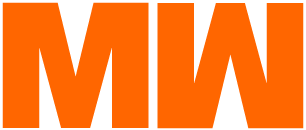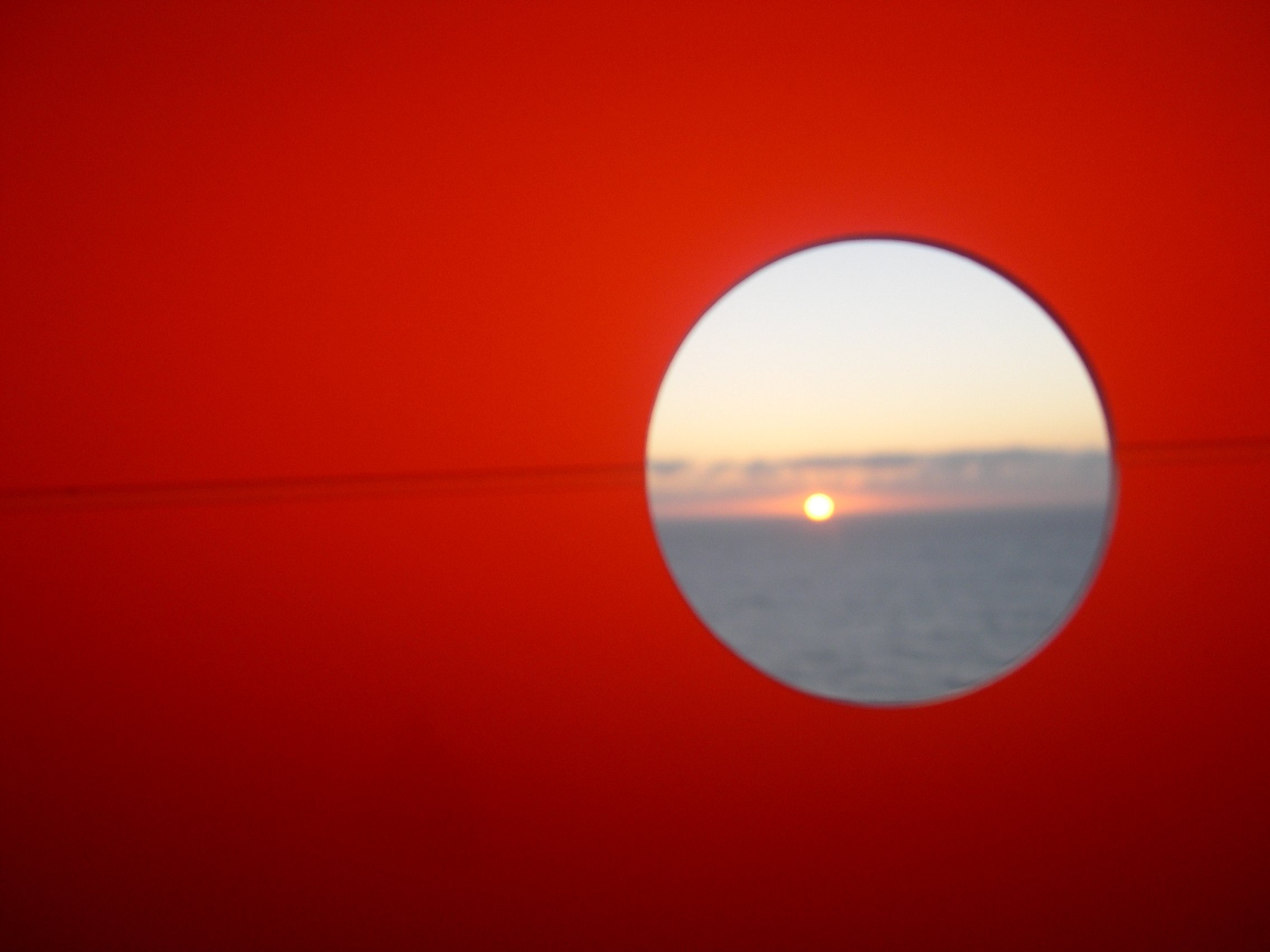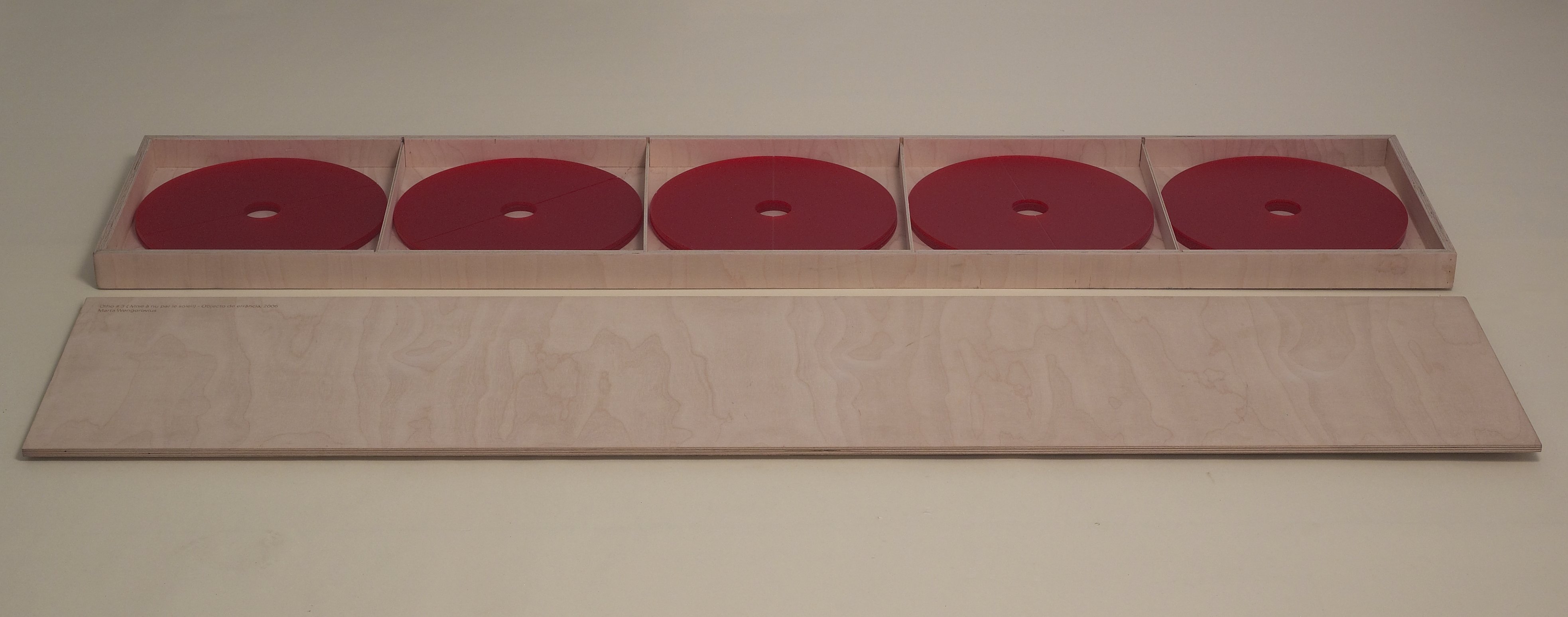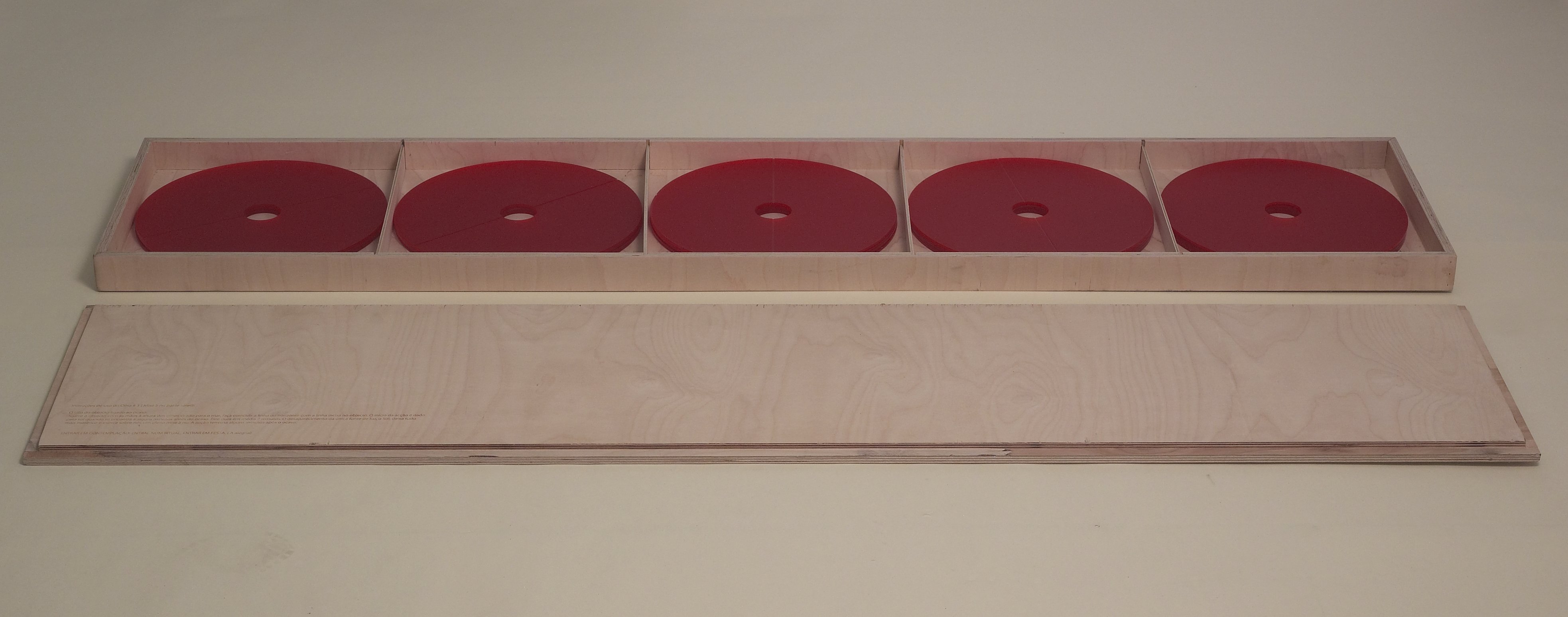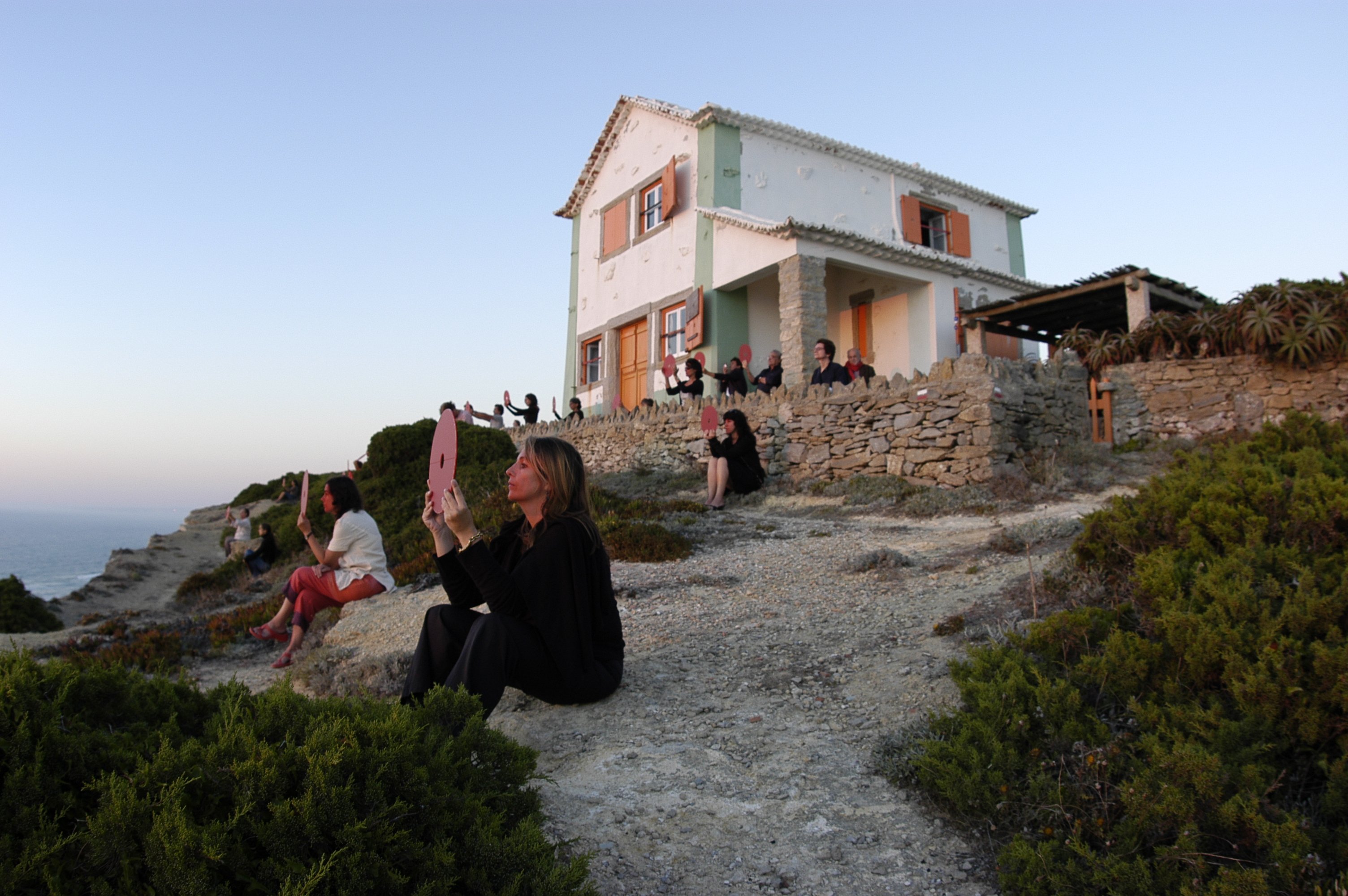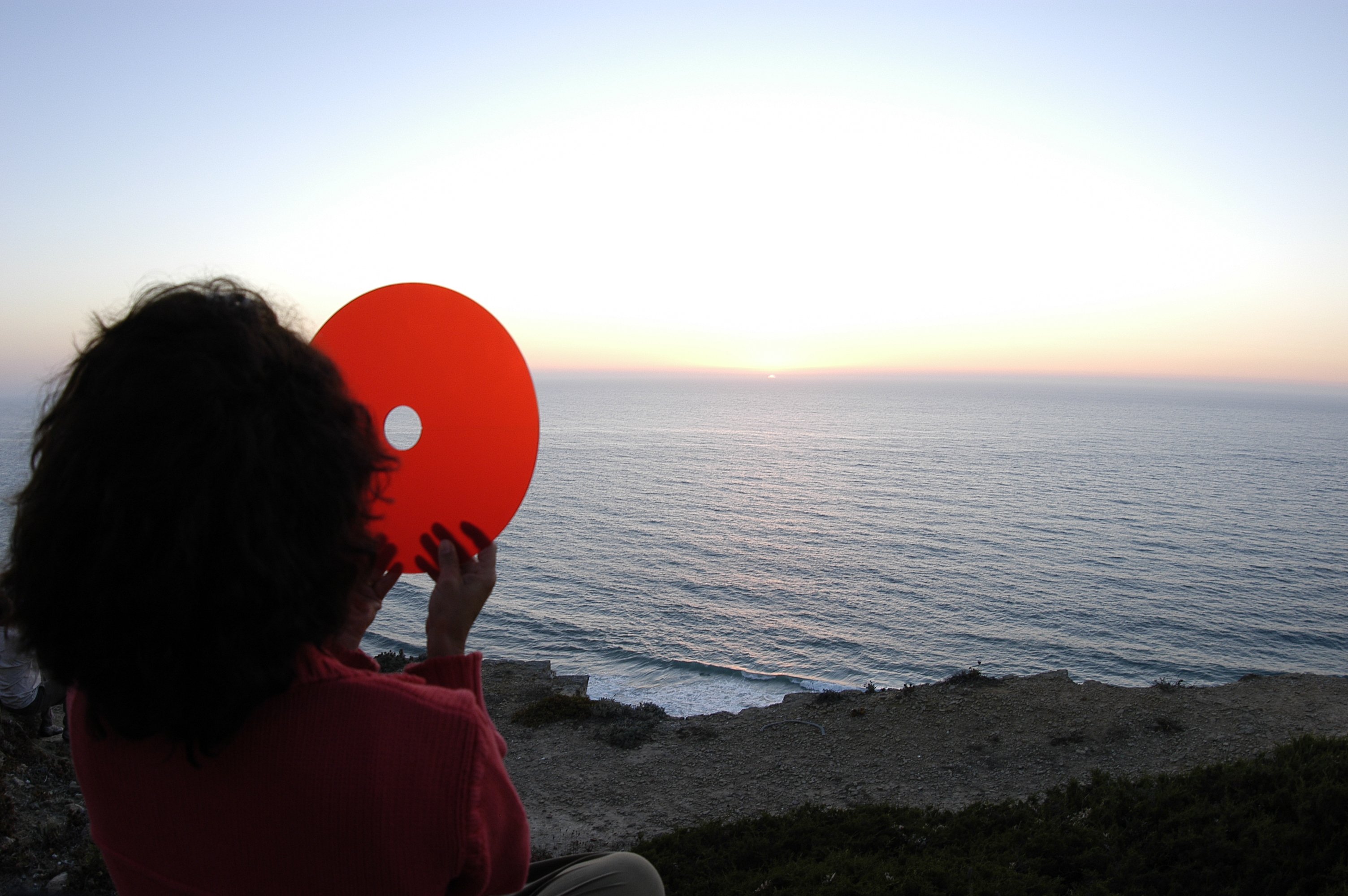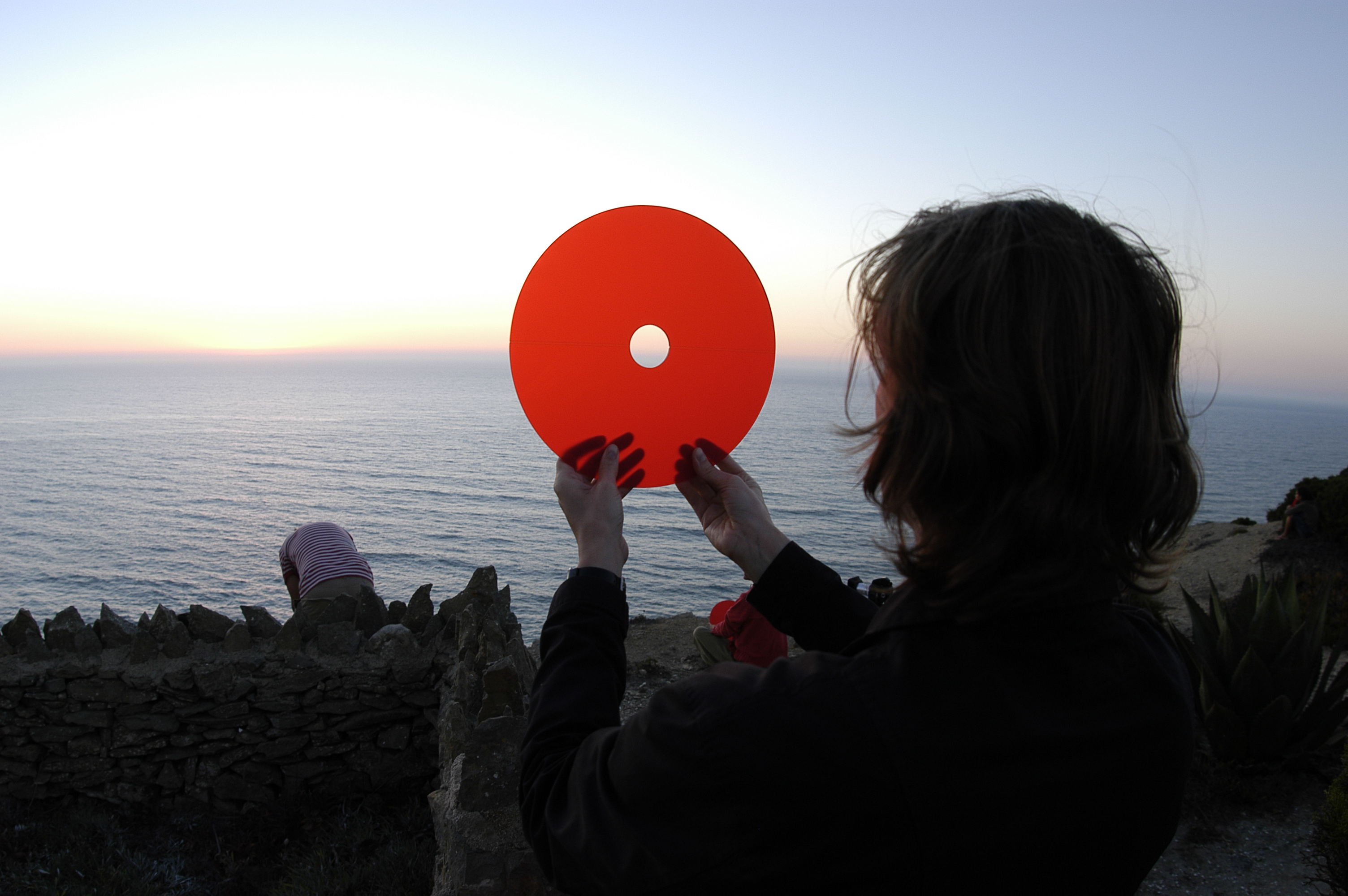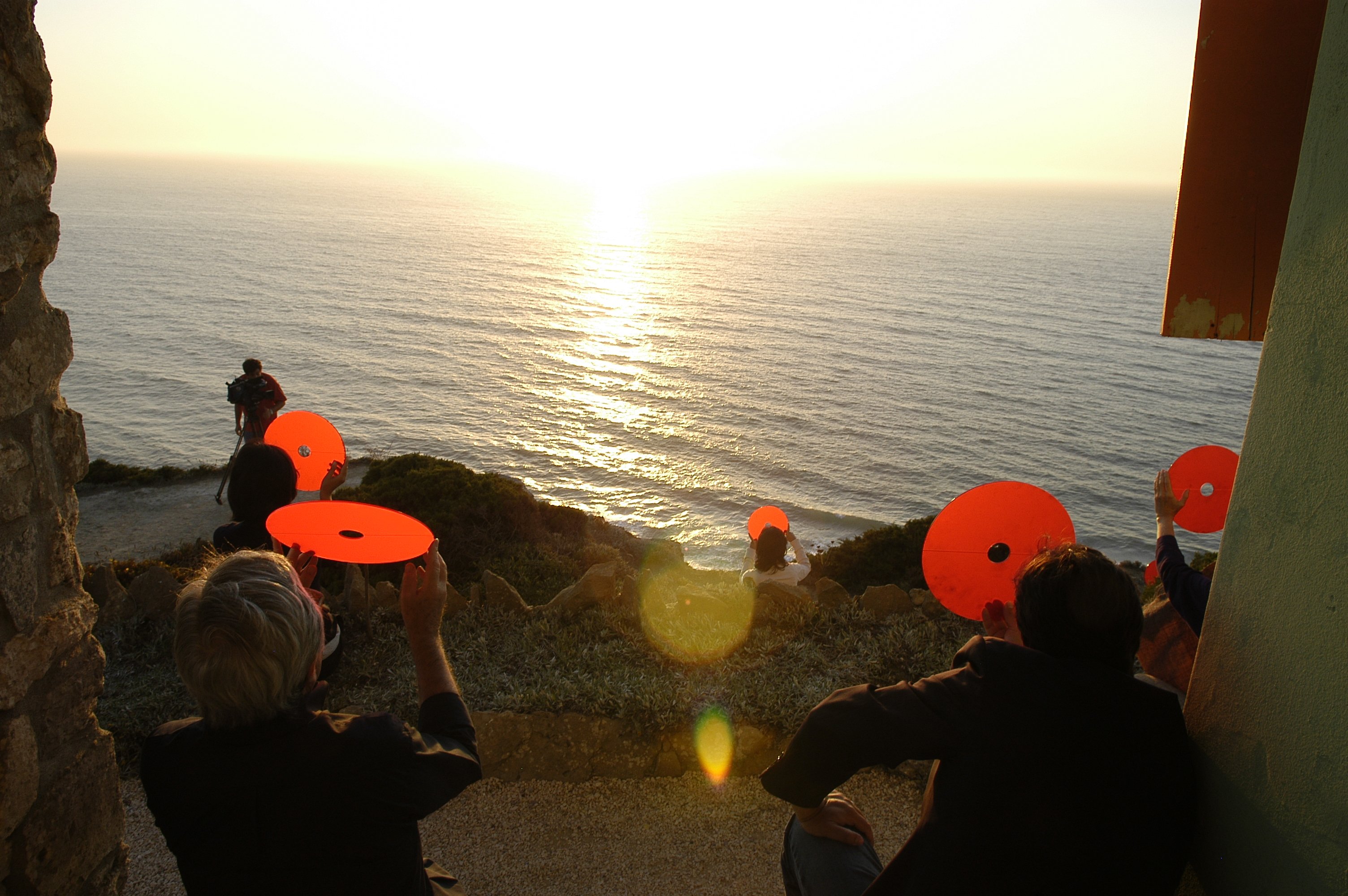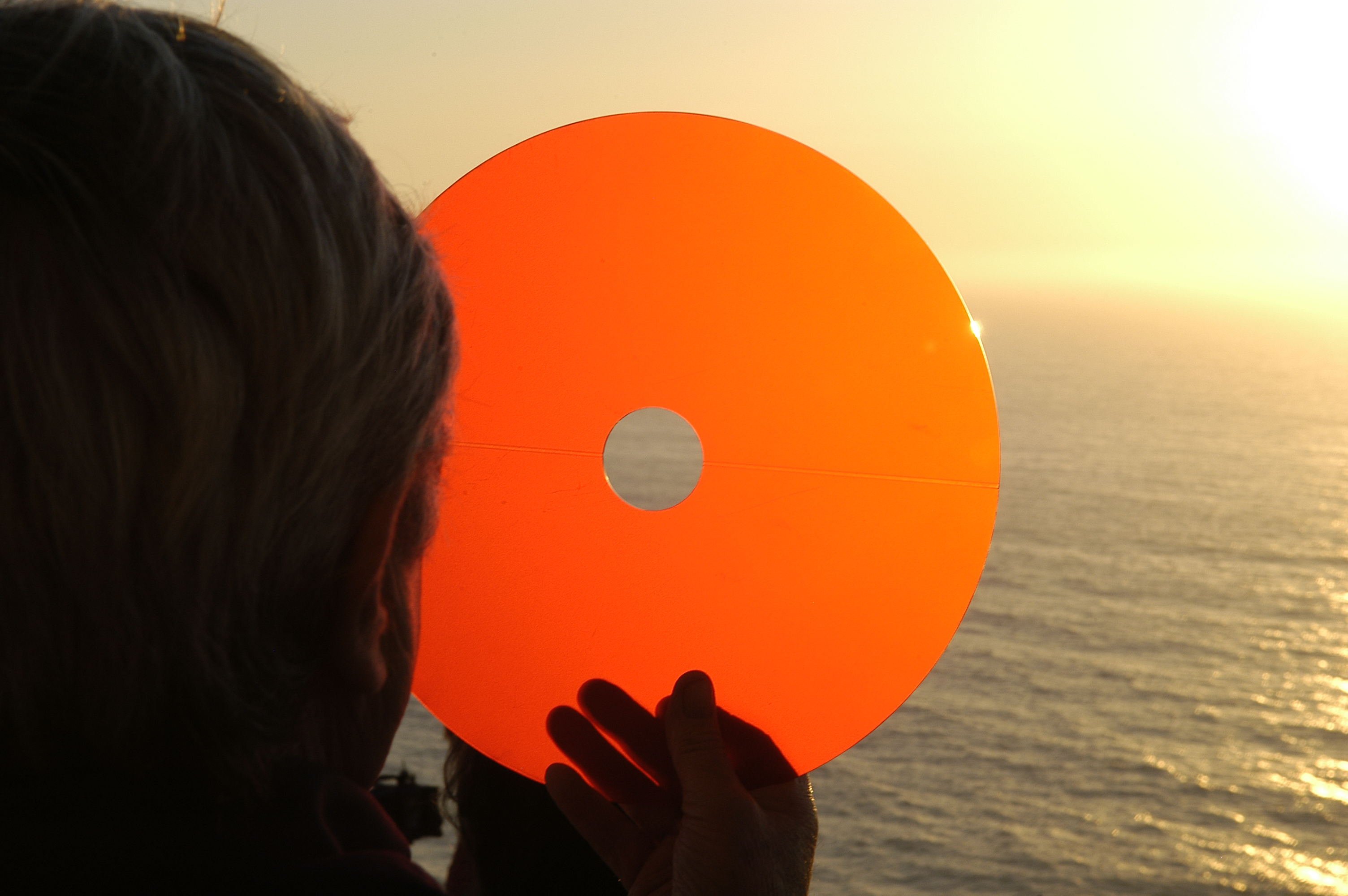Caixa de bétula com 25 peças em acrílico frosta vermelho translúcido
Ø 30 cm e 4,5 cm, espessura 0,3 cm
É atravessado por uma linha incisa de 1mm de profundidade x 1 mm de largura.
Instruções para o uso do Olho #3:
O uso do objecto ligado ao ocaso.
Agarre o objecto com as mãos à altura dos olhos virado para o mar, faça coincidir a linha do horizonte com a linha incisa no objecto. O inicio da acção é dado pelo sol quando se encontra a alguns minutos antes do ocaso. Este dura em média 7 minutos. O desaparecimento da única fonte de luz, o Sol, deixa tudo mais matérico e exerce sobre nós um efeito mise à nu. A acção termina alguns minutos após o ocaso.
O Olho #3 é um objecto para ser agarrado pelas duas mãos e ser colocado à altura a que estiverem os olhos de quem o usa, virado para o mar, fazendo coincidir a linha em que o mar e ceú se tocam com a linha incisa do Olho. Desta forma esta linha sobrepõe-se à linha do horizonte e estabelece uma relação continuada pela linha mar-ceú. Olho #3 ( mise a nu par le soleil) foi produzido numa edição de 25 exemplares.
Este evento Uso do Olho #3 iniciou-se com a escolha do lugar. Após várias visitas ao local levantavam-se várias questões que foram sendo resolvidas, pouco a pouco. A escolha do local deveria responder a duas questões fundamentais, por um lado, um bom visionamento do ocaso e por outro a possibilidade de este ser visionado por um grupo. Esta era deliberadamente a experiência mais aprofundada de Olhos enquanto Objectos de errância. Precedida de um estudo detalhado, onde tudo foi programado excepto a natureza do ocaso, única situação que não se podia controlar e como se apresentaria o sol naquele dia particular: em que direcção estaria o sol na data prevista para o evento, que perpendicularidade faria com o terreno onde se situa a casa. Na primeira fase do estudo o Olho #3 era uma moldura circular de grandes dimensões, imóvel, que serviria a todos os usufrutuários para observarem a descida do sol, imóveis também.
Tratava-se ainda de fazer coincidir o vazio circular do Olho #3 com o círculo do sol, numa determinada data. Descoberto o plano de intersecção da perpendicular que liga o sol ao terreno descobriríamos o lugar onde colocar o Olho. Mas com a descoberta desta perpendicular veio também a consciência de que só uma pessoa poderia colocar-se no eixo que intercepta na perpendicular o sol ( caso contrário teria de alargar o vazio circular de tal forma que transformava o Olho numa forma mais aparentada à moldura tradicional, o que não era desejado, naquela ocasião). Por outro lado, porquê uma perpendicular única? Porque não permitir que cada usufrutuário enquadre o sol através da descoberta da sua perpendicular? A resposta vem ao deixar que o terreno seja no seu todo a perpendicular ao ocaso. Que implica este abandonar de uma perpendicular única? De um ponto único de observação? A explosão do disco grande em discos de pequenas dimensões e portáteis que permitem a cada um o seu pôr-do-sol. fotomontagem da coreografia do percurso para o uso do Olho #3 Depois de encontrada esta nova ideia do uso da perpendicularidade tratava- se de optar pela disposição no terreno e do número de usufrutuários. Decidi que o silêncio seria imprescindível e que 2 metros entre cada pessoa poderia criar as condições ideais.
O terreno teria que abrigar não mais de 25 pessoas. Este número é encontrado após várias experiências em que se cruzaram as variantes visionamento do sol, distância mínima de 2 metros entre usufrutuários e selecção do lugar apropriado à vivência, num terreno irregular. Também a partir do terreno escolhi uma vivência do espaço que permitisse o captar da luz e do percurso, assim como um tempo para a apropriação do silêncio. Então descobri que a acção deveria ser estudada enquanto coreografia do ritual. No lugar escolhido existe um portão cor de laranja, esse serviria para a entrada. Entrando no portão e seguindo um pequeno caminho encontra-se uma pequena enseada, aí seria o lugar onde se seriam lidas as instruções do uso do Olho #3. Para que estas fossem lidas em voz alta, as pessoas seriam convidadas a juntarem-se em círculo.
No círculo, que remete para a forma dos Objectos de errância, foi trabalhado em grupo a respiração com a única finalidade de desacelerar o tempo. Após o que, seguindo outro pequeno caminho, nos dirigiríamos para o mar e para os objectos. Para que este evento acontecesse foram ensaiados diferentes momentos. A utilização do espaço como acima mencionei, a opção do silêncio como som, a disposição dos usufrutuários de forma a formarem um conjunto mas suficientemente distantes por sua vez para sentirem o seu lugar. Paralelamente foi iniciado o filme Uso do Olho #3 (mise a nu par le soleil) por Giovanni Cioni e por mim própria no mês de Abril. Após ensaios e estudos que duraram meio ano relizou-se o convite dirigido a 24 pessoas para o evento Uso do Olho #3 ( mise a nu par le soleil): O convite para este evento ainda se enquadra numa difusão controlada.
Birch box with 25 pieces of acrylic frost red
Ø 30 cm e 4,5 cm, thick 0,3 cm
Instructions for use:
The use of the object is connected with the sunset.
Hold the object with your hands at eye level facing the sea; align the line of the horizon with the line carved in the object. The action begins when the Sun is some minutes away from sunset. This lasts in average 7 minutes. With the disappearance of the only source of light, the Sun, everything becomes more material and exerts a mise à nu effect. The action ends a few minutes after the sunset.
Olho #3 (Eye #3) is an object to be grabbed by the two hands and put at the carrier’s eye level, turned to the sea, aiming to the coincidence with the line where the sea touches the sky with the Olho’s incisive line. In this way this line is superimposed to the horizon’s line, establishing a continued connection along the line sea-sky. Olho #3 (Eye #3) (mise a nu par le soleil) was produced in a 25 exemplars’ edition.
This event Uso do Olho #3 (the use of Eye #3) was initiated by the choice of the place. After several visits to the place, several questions were raised and progressively answered, one by one. The site’s choice should answer two fundamental questions: on the one hand, a good viewing of the sunset, and, on the other hand, the possibility of a group viewing. This was deliberately the deepest experience of the Olhos as Objects of Errantry. Preceded by a detailed study, where everything was programmed with the exception of the sunset’s nature, the only situation which could not be controlled for was how the sun would present itself on that particular day: in which direction would be the sun on the previewed event’s date, which perpendicularity would it do with the ground where the house was located.
On the first study stage, Olho #3 (Eye #3) was a round frame of huge dimensions, immobile, which was to be used by all the (consequently) immobile users to watch the sun setting. In stake was the alignment of Olho #3’s (Eye #3) void with the roundness of the sun, in a predetermined date. Found the intersection plan between the perpendicular that links the sun to the ground, we would find the Olho’s place. But with the discovery of this perpendicular came the consciousness that only one single person would be able to be on the axe that intercepts in the sun’s perpendicular (otherwise, I would have to enlarge the empty circle in such way that the Olho would be transformed into something much similar to a traditional frame, which was not the desired at the time). On the other hand, why a single perpendicular? Why not allow each user the framing of the sun through the discovery of this perpendicular?
The answer comes by letting the terrain become, in its wholeness, the perpendicular to the sun. What are the implications of giving up a single perpendicular? Of a single observation point? The explosion of the big disk into small and portable disks that permit to each one one’s own sunset. photomontage of the path’s choreography for the use of ’s After the discovery of this new idea about the use of the perpendicular, the question of the number and positioning of the users still remained. I decided that the silence was essential and that a distance of 2 m between people could create the ideal conditions. The land would have to give cover to no more than 25 people.
This number is found after several experiences which took into account the variables sun viewing, minimum distance of 2m between people, and the selection of the particular locations for the lived experience to take place, in an irregular terrain. Rehearsal for the distribution of people on site – Casa branca, Azenhas do Mar, June 2006 It was also based on the terrain that I chose a spatial experience that would allow the capture of both the light and the path, as well as a time for the appropriation of silence. I then discovered that the action should be studied as the choreography of a ritual. On the chosen location there is an orange gate, this would fit the entrance. Getting through the gate and following a narrow path there lays a small bay, there would be the place for reading the instructions of Uso do Olho #3 ( the use of Eye #3). For these to be read out loud, everyone was invited to gather in a circle. In the circle, which suggests the form of Objectos de errância (Objects of Errantry), breathing was collectively worked with the single finality of slowing down the time. Afterwards, following another narrow path, we aimed to the sea and to the objects.
For this event to take place, different moments were rehearsed. The space’s use, as I have mentioned above, the option of silence as sound, the placement of the users in such a way that they would still constitute a whole, despite the distance needed for one to be able to feel one’s own place. Simultaneously, the movie Uso do Olho #3 (the use of Objects of Errantry) (mise a nu par le soleil) by Giovanni Cioni and myself started in April.
After rehearsals and studies that lasted half an year, the invitation for the event Uso do Olho #3 (the use of Eye #3) (mise a nu par le soleil) was extended to 24 people: The invitation for this event is still framed on a controlled diffusion. The invitations were addressed nominally and included ordinary data, common to any event.
- + PT
-
Caixa de bétula com 25 peças em acrílico frosta vermelho translúcido
Ø 30 cm e 4,5 cm, espessura 0,3 cm
É atravessado por uma linha incisa de 1mm de profundidade x 1 mm de largura.Instruções para o uso do Olho #3:
O uso do objecto ligado ao ocaso.
Agarre o objecto com as mãos à altura dos olhos virado para o mar, faça coincidir a linha do horizonte com a linha incisa no objecto. O inicio da acção é dado pelo sol quando se encontra a alguns minutos antes do ocaso. Este dura em média 7 minutos. O desaparecimento da única fonte de luz, o Sol, deixa tudo mais matérico e exerce sobre nós um efeito mise à nu. A acção termina alguns minutos após o ocaso.
O Olho #3 é um objecto para ser agarrado pelas duas mãos e ser colocado à altura a que estiverem os olhos de quem o usa, virado para o mar, fazendo coincidir a linha em que o mar e ceú se tocam com a linha incisa do Olho. Desta forma esta linha sobrepõe-se à linha do horizonte e estabelece uma relação continuada pela linha mar-ceú. Olho #3 ( mise a nu par le soleil) foi produzido numa edição de 25 exemplares.
Este evento Uso do Olho #3 iniciou-se com a escolha do lugar. Após várias visitas ao local levantavam-se várias questões que foram sendo resolvidas, pouco a pouco. A escolha do local deveria responder a duas questões fundamentais, por um lado, um bom visionamento do ocaso e por outro a possibilidade de este ser visionado por um grupo. Esta era deliberadamente a experiência mais aprofundada de Olhos enquanto Objectos de errância. Precedida de um estudo detalhado, onde tudo foi programado excepto a natureza do ocaso, única situação que não se podia controlar e como se apresentaria o sol naquele dia particular: em que direcção estaria o sol na data prevista para o evento, que perpendicularidade faria com o terreno onde se situa a casa. Na primeira fase do estudo o Olho #3 era uma moldura circular de grandes dimensões, imóvel, que serviria a todos os usufrutuários para observarem a descida do sol, imóveis também.
Tratava-se ainda de fazer coincidir o vazio circular do Olho #3 com o círculo do sol, numa determinada data. Descoberto o plano de intersecção da perpendicular que liga o sol ao terreno descobriríamos o lugar onde colocar o Olho. Mas com a descoberta desta perpendicular veio também a consciência de que só uma pessoa poderia colocar-se no eixo que intercepta na perpendicular o sol ( caso contrário teria de alargar o vazio circular de tal forma que transformava o Olho numa forma mais aparentada à moldura tradicional, o que não era desejado, naquela ocasião). Por outro lado, porquê uma perpendicular única? Porque não permitir que cada usufrutuário enquadre o sol através da descoberta da sua perpendicular? A resposta vem ao deixar que o terreno seja no seu todo a perpendicular ao ocaso. Que implica este abandonar de uma perpendicular única? De um ponto único de observação? A explosão do disco grande em discos de pequenas dimensões e portáteis que permitem a cada um o seu pôr-do-sol. fotomontagem da coreografia do percurso para o uso do Olho #3 Depois de encontrada esta nova ideia do uso da perpendicularidade tratava- se de optar pela disposição no terreno e do número de usufrutuários. Decidi que o silêncio seria imprescindível e que 2 metros entre cada pessoa poderia criar as condições ideais.
O terreno teria que abrigar não mais de 25 pessoas. Este número é encontrado após várias experiências em que se cruzaram as variantes visionamento do sol, distância mínima de 2 metros entre usufrutuários e selecção do lugar apropriado à vivência, num terreno irregular. Também a partir do terreno escolhi uma vivência do espaço que permitisse o captar da luz e do percurso, assim como um tempo para a apropriação do silêncio. Então descobri que a acção deveria ser estudada enquanto coreografia do ritual. No lugar escolhido existe um portão cor de laranja, esse serviria para a entrada. Entrando no portão e seguindo um pequeno caminho encontra-se uma pequena enseada, aí seria o lugar onde se seriam lidas as instruções do uso do Olho #3. Para que estas fossem lidas em voz alta, as pessoas seriam convidadas a juntarem-se em círculo.
No círculo, que remete para a forma dos Objectos de errância, foi trabalhado em grupo a respiração com a única finalidade de desacelerar o tempo. Após o que, seguindo outro pequeno caminho, nos dirigiríamos para o mar e para os objectos. Para que este evento acontecesse foram ensaiados diferentes momentos. A utilização do espaço como acima mencionei, a opção do silêncio como som, a disposição dos usufrutuários de forma a formarem um conjunto mas suficientemente distantes por sua vez para sentirem o seu lugar. Paralelamente foi iniciado o filme Uso do Olho #3 (mise a nu par le soleil) por Giovanni Cioni e por mim própria no mês de Abril. Após ensaios e estudos que duraram meio ano relizou-se o convite dirigido a 24 pessoas para o evento Uso do Olho #3 ( mise a nu par le soleil): O convite para este evento ainda se enquadra numa difusão controlada.
- + EN
-
Birch box with 25 pieces of acrylic frost red
Ø 30 cm e 4,5 cm, thick 0,3 cmInstructions for use:
The use of the object is connected with the sunset.
Hold the object with your hands at eye level facing the sea; align the line of the horizon with the line carved in the object. The action begins when the Sun is some minutes away from sunset. This lasts in average 7 minutes. With the disappearance of the only source of light, the Sun, everything becomes more material and exerts a mise à nu effect. The action ends a few minutes after the sunset.
Olho #3 (Eye #3) is an object to be grabbed by the two hands and put at the carrier’s eye level, turned to the sea, aiming to the coincidence with the line where the sea touches the sky with the Olho’s incisive line. In this way this line is superimposed to the horizon’s line, establishing a continued connection along the line sea-sky. Olho #3 (Eye #3) (mise a nu par le soleil) was produced in a 25 exemplars’ edition.
This event Uso do Olho #3 (the use of Eye #3) was initiated by the choice of the place. After several visits to the place, several questions were raised and progressively answered, one by one. The site’s choice should answer two fundamental questions: on the one hand, a good viewing of the sunset, and, on the other hand, the possibility of a group viewing. This was deliberately the deepest experience of the Olhos as Objects of Errantry. Preceded by a detailed study, where everything was programmed with the exception of the sunset’s nature, the only situation which could not be controlled for was how the sun would present itself on that particular day: in which direction would be the sun on the previewed event’s date, which perpendicularity would it do with the ground where the house was located.
On the first study stage, Olho #3 (Eye #3) was a round frame of huge dimensions, immobile, which was to be used by all the (consequently) immobile users to watch the sun setting. In stake was the alignment of Olho #3’s (Eye #3) void with the roundness of the sun, in a predetermined date. Found the intersection plan between the perpendicular that links the sun to the ground, we would find the Olho’s place. But with the discovery of this perpendicular came the consciousness that only one single person would be able to be on the axe that intercepts in the sun’s perpendicular (otherwise, I would have to enlarge the empty circle in such way that the Olho would be transformed into something much similar to a traditional frame, which was not the desired at the time). On the other hand, why a single perpendicular? Why not allow each user the framing of the sun through the discovery of this perpendicular?
The answer comes by letting the terrain become, in its wholeness, the perpendicular to the sun. What are the implications of giving up a single perpendicular? Of a single observation point? The explosion of the big disk into small and portable disks that permit to each one one’s own sunset. photomontage of the path’s choreography for the use of ’s After the discovery of this new idea about the use of the perpendicular, the question of the number and positioning of the users still remained. I decided that the silence was essential and that a distance of 2 m between people could create the ideal conditions. The land would have to give cover to no more than 25 people.
This number is found after several experiences which took into account the variables sun viewing, minimum distance of 2m between people, and the selection of the particular locations for the lived experience to take place, in an irregular terrain. Rehearsal for the distribution of people on site – Casa branca, Azenhas do Mar, June 2006 It was also based on the terrain that I chose a spatial experience that would allow the capture of both the light and the path, as well as a time for the appropriation of silence. I then discovered that the action should be studied as the choreography of a ritual. On the chosen location there is an orange gate, this would fit the entrance. Getting through the gate and following a narrow path there lays a small bay, there would be the place for reading the instructions of Uso do Olho #3 ( the use of Eye #3). For these to be read out loud, everyone was invited to gather in a circle. In the circle, which suggests the form of Objectos de errância (Objects of Errantry), breathing was collectively worked with the single finality of slowing down the time. Afterwards, following another narrow path, we aimed to the sea and to the objects.
For this event to take place, different moments were rehearsed. The space’s use, as I have mentioned above, the option of silence as sound, the placement of the users in such a way that they would still constitute a whole, despite the distance needed for one to be able to feel one’s own place. Simultaneously, the movie Uso do Olho #3 (the use of Objects of Errantry) (mise a nu par le soleil) by Giovanni Cioni and myself started in April.
After rehearsals and studies that lasted half an year, the invitation for the event Uso do Olho #3 (the use of Eye #3) (mise a nu par le soleil) was extended to 24 people: The invitation for this event is still framed on a controlled diffusion. The invitations were addressed nominally and included ordinary data, common to any event.
